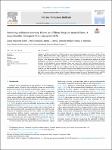Detecting sediment recovery below an offshore longline mussel farm: A macrobenthic Biological Trait Analysis (BTA)
| dc.contributor.author | Mascorda-Cabre, L | |
| dc.contributor.author | Hosegood, P | |
| dc.contributor.author | Attrill, MJ | |
| dc.contributor.author | Bridger, D | |
| dc.contributor.author | Sheehan, EV | |
| dc.date.accessioned | 2023-11-01T15:05:02Z | |
| dc.date.available | 2023-11-01T15:05:02Z | |
| dc.date.issued | 2023-10 | |
| dc.identifier.issn | 0025-326X | |
| dc.identifier.issn | 1879-3363 | |
| dc.identifier.other | 115556 | |
| dc.identifier.uri | https://pearl.plymouth.ac.uk/handle/10026.1/21505 | |
| dc.description.abstract |
Expansion of bivalve aquaculture offshore reports lower environmental impacts compared to inshore farms. Taking a Before-After Control-Impact approach, this study presents the first functional diversity analysis and long-term Biological Trait Analysis (BTA) of infauna functional traits following the development of the United Kingdom's first large-scale, offshore longline mussel farm. Located in an area historically impacted by mobile fishing gear, farm sites had the greatest number of taxa and abundance compared to control sites. Functional diversity varied significantly across treatments (farm, near control, far control); while Functional Diversity, Richness, Divergence and Dispersion increased over time within the farm, Functional Evenness and Redundancy decreased. Bioturbation, body size, diet, feeding mode, life span, motility, sediment position, sensitivity and substrate type were chosen for Community-level Weighted Mean analysis, depicting the most frequently affected biological traits by shellfish farming. Farm sites developed a wider range of traits enhancing ecosystem function and habitat recovery after years of seabed damage. Outcomes support the use of functional diversity and BTA analysis to perform ecosystem assessment, supporting decision-makers implement policy and management. | |
| dc.format.extent | 115556-115556 | |
| dc.format.medium | Print-Electronic | |
| dc.language | en | |
| dc.publisher | Elsevier BV | |
| dc.subject | Aquaculture | |
| dc.subject | Ecology | |
| dc.subject | Functional traits | |
| dc.subject | Infauna | |
| dc.subject | Ecosystem assessment | |
| dc.subject | Other effective conservation measures | |
| dc.subject | CWM | |
| dc.title | Detecting sediment recovery below an offshore longline mussel farm: A macrobenthic Biological Trait Analysis (BTA) | |
| dc.type | journal-article | |
| dc.type | Article | |
| plymouth.author-url | https://www.ncbi.nlm.nih.gov/pubmed/37738875 | |
| plymouth.volume | 195 | |
| plymouth.publication-status | Published | |
| plymouth.journal | Marine Pollution Bulletin | |
| dc.identifier.doi | 10.1016/j.marpolbul.2023.115556 | |
| plymouth.organisational-group | |Plymouth | |
| plymouth.organisational-group | |Plymouth|Research Groups | |
| plymouth.organisational-group | |Plymouth|PRIMaRE Publications | |
| plymouth.organisational-group | |Plymouth|Faculty of Science and Engineering | |
| plymouth.organisational-group | |Plymouth|Faculty of Science and Engineering|School of Biological and Marine Sciences | |
| plymouth.organisational-group | |Plymouth|Research Groups|Marine Institute | |
| plymouth.organisational-group | |Plymouth|REF 2021 Researchers by UoA | |
| plymouth.organisational-group | |Plymouth|Users by role | |
| plymouth.organisational-group | |Plymouth|Users by role|Academics | |
| plymouth.organisational-group | |Plymouth|REF 2021 Researchers by UoA|UoA07 Earth Systems and Environmental Sciences | |
| plymouth.organisational-group | |Plymouth|Users by role|Researchers in ResearchFish submission | |
| dc.publisher.place | England | |
| dcterms.dateAccepted | 2023-09-15 | |
| dc.date.updated | 2023-11-01T15:04:55Z | |
| dc.rights.embargodate | 2023-11-3 | |
| dc.identifier.eissn | 1879-3363 | |
| rioxxterms.versionofrecord | 10.1016/j.marpolbul.2023.115556 |


